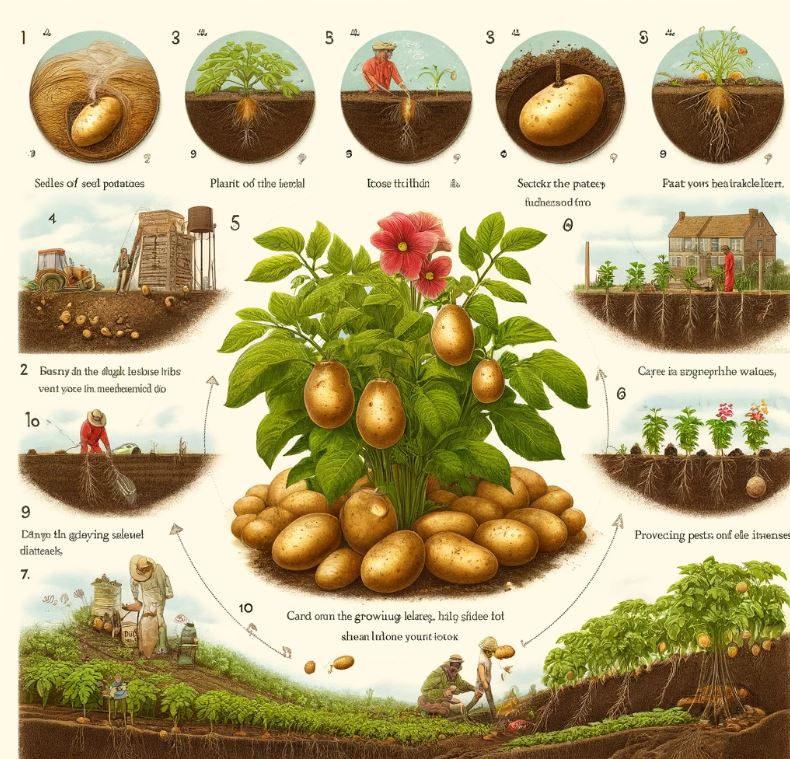Want to know how to grow potatoes? Growing potatoes is a rewarding experience, offering the joy of harvesting your own delicious tubers from the garden. This guide synthesizes expert advice from The Old Farmer’s Almanac, Rural Sprout, and Backyard Digs to provide you with a step-by-step approach to cultivating potatoes, alongside exploring expert opinions and topics related to this versatile vegetable.
Step-by-Step Guide to Growing Potatoes
- Choose the Right Variety:
- Select from early-season, mid-season, or late crops based on when you want to harvest. Consider the texture and flavor preferences for your culinary uses.
- Preparation:
- Soil Preferences: Thrive in well-drained, loamy, and slightly acidic soil (pH 5.0-6.0).
- Location & Soil Preparation: Ensure a full sun location and amend soil with compost or aged manure for fertility.
- Planting:
- Seed Potatoes: Use certified seed potatoes. If large, cut them into pieces with at least one or two eyes each. Let cut pieces cure to form a protective callus.
- Plant in early spring, post the frost threat, in trenches or raised beds for better drainage. Space seed potatoes about 12 inches apart in rows.
- Care:
- Watering: Provide 1 to 2 inches of water per week, focusing on consistent moisture especially during tuber formation.
- Hilling: Pile soil or organic mulch around plants as they grow to protect tubers from sunlight and prevent greening.
- Pest & Disease Management:
- Stay vigilant against common pests like the Colorado Potato Beetle and diseases such as late blight. Use resistant varieties and practice crop rotation.
- Harvesting & Storage:
- Harvest once the foliage starts to yellow and wilt. Store potatoes in a cool, dark place.
FAQs – How to Grow Potatoes
- When is the best time to plant potatoes?
- Plant in early spring, after the last frost. The exact timing depends on your climate zone.
- How deep should potatoes be planted?
- Plant seed potatoes about 3 inches deep with rows spaced about 3 feet apart.
- Can I grow potatoes in containers?
- Yes, potatoes can be successfully grown in large containers, old compost sacks, or potato sacks with proper care and watering (The Old Farmer’s Almanac).
- How often should I water my potato plants?
- Provide about 1 to 2 inches of water per week, ensuring even moisture throughout the growing period.
- What is ‘hilling’ and why is it important?
- Hilling involves piling soil around the growing stems to protect developing tubers from sunlight and to encourage more tuber formation. It’s essential for preventing green, toxic tubers (Rural Sprout).
- How do I prevent pests and diseases in my potato crop?
- Choose disease-resistant varieties, practice crop rotation, and physically remove pests when possible. Also, ensure good air circulation around plants.
- When should I harvest potatoes?
- Harvest once the plant’s foliage begins to yellow and die back, signaling the tubers have matured.
- Can potatoes be grown without direct sunlight?
- Potatoes prefer full sun but can tolerate partial shade, although this may affect the yield.
- How long do potatoes take to grow?
- Early-season potatoes can mature in as little as 60-80 days, while late-season varieties may take 100-130 days (The Old Farmer’s Almanac).
- What should I do with green potatoes?
- Green potatoes contain solanine, a toxic compound. It’s best to discard any green portions or potatoes entirely.
5 Detailed Questions
- Chitting Potatoes:
- Chitting, or pre-sprouting, seed potatoes can provide a head start on growth and potentially lead to an earlier harvest. Though not essential, it’s recommended to begin chitting about 6-8 weeks before the intended planting date (Rural Sprout).
- Watering Techniques for Potatoes:
- Proper watering is crucial, especially in dry areas or under cover. Drip irrigation can ensure consistent watering and reduce water use, making it an excellent option for maintaining the necessary moisture levels without over-watering (Rural Sprout).
- Enhancing Soil Fertility:
- Adding organic matter such as comfrey leaves or seaweed at planting can boost fertility and yield. It’s beneficial to enrich the planting trenches with these materials for healthier growth (Rural Sprout).
- Protecting Potatoes from Frost:
- Late frosts can damage young potato foliage. Protecting plants with fleece or soil hilling can safeguard againstfrost damage, especially in early growth stages. Implementing coverings during cold snaps or utilizing soil to cover emerging shoots can mitigate frost impact, ensuring the plant’s energy leads to a successful crop (The Old Farmer’s Almanac).
- Harvesting Techniques for Optimal Yield:
- Harvesting at the right time is crucial for potato quality and storage. Observing the plant’s lifecycle and allowing tubers to mature fully before harvesting ensures the best quality potatoes. Early harvesting can lead to smaller potatoes, while late harvesting can increase the risk of disease and pest damage. It’s advisable to wait for the foliage to yellow and wilt before harvesting, indicating tubers have reached maturity (The Old Farmer’s Almanac).
